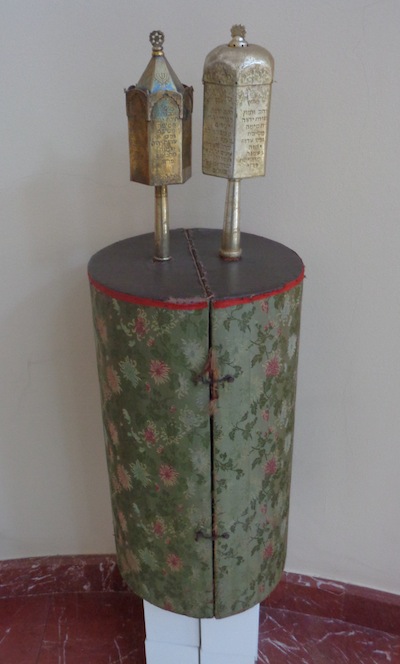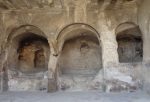Queen Tamar’s Hall at Uplistsikhe. (photo by Deborah Rubin Fields)
I would venture to say not many people know about the ancient Jewish community of Georgia. Yet, Jews have lived there since at least the fourth century CE and, according to various legends from the Second Temple period, even earlier.
Although scant written information from prior to the end of the 18th century exists, stories have it that Georgian Jews have a long history. According to one oral tradition, the community goes back to the exile of the Ten Tribes by the Assyrians. Others place its origins to the destruction of the First Temple in 586 BCE. And yet others claim that, since there was a large Jewish community in neighbouring Armenia from the first through the fourth centuries CE, it is probable that Jewish traders likewise established themselves in Georgia. These are just some of the theories.
The earliest solid evidence comes from the archeological discovery of a fourth century CE Jewish tombstone. This tombstone was found in Mtskheta, an important early Christian city located on the River Aragvi. The tombstone is dedicated to a Jew named Yosef Chazon and it features an Aramaic inscription engraved in Hebrew letters. Today, it is on display at Tbilisi’s David Baazov Museum of History of the Jews of Georgia and Georgian-Jewish Relations. (An aside: Although the sacred object is nowhere to be seen, the town’s Svetitskhoveli Cathedral claims to have the robe that Jesus wore at the time of his crucifixion. As the story goes, this robe was brought from Jerusalem by two Georgian Jews: Elioz, or Elias, and Longinoz.)

Possibly because they were viewed as unpretentious craftsmen and pedlars, Jews faced relatively little antisemitism. Under the medieval feudal system, they were considered serfs. As serfs, they were never forced to convert, although there seemed to have been some incentive: one document states that Daniel Aranashbili, an apostate serf, received a total tax exemption. (See Gershon Ben-Oren’s essay, “The History of the Jews of Georgia Until the Communist Regime” in The Land of the Golden Fleece: The Jews of Georgia-History and Culture.)
Jumping ahead to the 19th-century rule of the Russian czar, there were a handful of blood libel cases that, while admittedly painful, did not end up in the massacres that occurred in other parts of Europe. Even during the repressive Soviet era, when Jewish institutions were closed, the Tbilisi Jewish community somehow succeeded in having their cemeteries left intact – unlike the local Muslims and Armenians, whose Georgian cemeteries were desecrated.
Internally, the Jewish community had its differences. For instance, at the end of the 19th century, there was significant resistance to Zionism. Rabbi David Baazov – who the czar appointed as the official rabbi of Oni – was one of the community’s first Zionist advocates. He faced such fierce opposition from wealthy community members that he was forced to appeal for funds from early Zionist leader Menachem Ussishkin. Unfortunately, when, in 1917, no financial assistance was offered, Baazov had to close his school. (Today, the Jewish museum in Tbilisi is named after Baazov.)
But here is something amazing about this quiet community. It was “carried away” by the achievements of the Israeli Defence Forces in the Six Day War. In 1969, knowing the risks in “making waves” during Soviet rule (Stalin, for example, who hailed from Georgia, had personally signed the death penalties of 3,600 countrymen), 18 Georgian Jewish families were the first people to publicly petition the United Nations Human Rights Committee with their request to move to Israel.
Most of the 80,000 Georgian Jews (figures from 1970s) made aliyah in two recent waves: in the 1970s and again in the 1990s, when the USSR collapsed. Reportedly, 3,000 to 5,000 still live in the European (because of the Caucasus Mountains, some would say Asian) country of Georgia. Significantly, only recently has Tbilisi become the main centre for the Jewish community. In fact, until the first big aliyah, the Georgian Jewish community lived in several other locations, including Kutaisi, Batumi, Oni, Akhaltsikhe, Akhalkalak, Sarami, Kareli and Gori.
Historically, Georgia’s Mizrahi and Ashkenazi communities have remained separate. In today’s Tbilisi, Shaarei Tefillah Synagogue stands in the Old Town area. This congregation is more than 100 years old. There is also a Chabad synagogue. A kosher restaurant is located near Shaarei Tefillah.
At present, you will hear different opinions about the vitality of the current Jewish community. Some insist that, unlike other former Soviet Union countries, there is vibrant Jewish life in Georgia, with little assimilation. Others contend that, with the dwindling population, life is bleak for some of the older members of the Jewish community and tenuous for the younger generation, who are at risk of losing their Jewish identity.
Georgian Jews have been proud of their heritage. For instance, one wealthy Armenian Jew living in Tbilisi, Ghazar Sarkisian, built his wife a stunning house with stained glass windows displaying the Star of David.
And, speaking of David, everywhere you go in Georgia, you will see paintings and statues of two Georgian leaders who had Old Testament names: King David the Builder (1089-1125) and his great-granddaughter Queen Tamar (1184-1213). These two rulers are recognized for their ability to unify the nation. But, in addition, there are stories that their Bagrationi ancestors descended from the biblical King David. Hence, some believe these rulers had Jewish roots. Whatever their true origin, in today’s Georgia, these names remain popular with the general population.
When in Georgia …
- For the adventurous, there is cycling, and mountain and hill climbing. However, travelers should note that, because of severe weather conditions, a number of roads leading to the Caucasus Mountains close for months at a time.
- Visit the cave city of Uplistsikhe. Although there is no evidence that she was ever there, you’ll find a large space called Queen Tamar’s Hall. Either way, the caves, which first housed pagan communities, make for an interesting stop.
- Even if you don’t drink wine, it is worth going to a traditional winery to see the unique way Georgians have historically made wine.
- Besides wine, bread is another big part of Georgian life. Check out a bakery that makes shoti puri, a flatbread resembling a canoe in shape. It is a simple, handmade mixture of flour, water, salt and yeast. The bread is baked in a strange oven called a tone (pronounced “tone-ay”). This oven is a circular, brick-lined oven dug into the floor with a gas or wood fire at the bottom. The bread is placed onto the side of the tone. For the bakers, it is hot and strenuous work, especially when trying to reach the spaces at the bottom of the oven. The bread is ready in a matter of minutes. It is then scrapped off the sides with a paddle.
- For those who like to take in the local scene by walking, Tbilisi is the place to be. Walk slowly through the Old Town to see how grand this city once was. From the crumbling carved wooden porches to the faded hand-painted vestibules, you can still feel the city’s architectural beauty. There are a number of rehabilitation projects underway, but much needs to be done.
- Another way to see a bit of times past is to go to Tbilisi’s Dry Bridge Market. This flea market specializes in nostalgia, selling silverware, china and glassware. You can get a shaggy shepherd’s hat, accordions, sewing machines, cameras, record albums, hand guns and knives (!) and, of course, Soviet memorabilia. It also has a large section of new, locally made paintings and shawls.
- Though the exhibits are not posted in English, the State Museum of Georgian Folk Songs and Instruments has a small, but nice, collection of regional musical instruments (including a shofar). While I was visiting, the curator played a European street organ, an upright organ and operated some of the early musical recording devices.
Deborah Rubin Fields is an Israel-based features writer. She is also the author of Take a Peek Inside: A Child’s Guide to Radiology Exams, published in English, Hebrew and Arabic.

